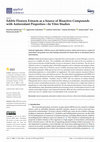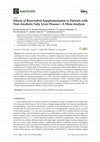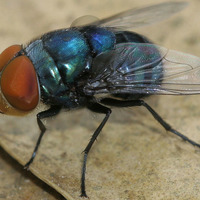Papers by Katarzyna Janda
Nutrients, Apr 15, 2024
This article is an open access article distributed under the terms and conditions of the Creative... more This article is an open access article distributed under the terms and conditions of the Creative Commons Attribution (CC BY
Applied sciences, Feb 27, 2021
This article is an open access article distributed under the terms and conditions of the Creative... more This article is an open access article distributed under the terms and conditions of the Creative Commons Attribution (CC BY
Pomeranian journal of life sciences, Sep 5, 2018
In this paper the structure of vitamin C, its physical and chemi cal characteristics, and occurre... more In this paper the structure of vitamin C, its physical and chemi cal characteristics, and occurrence are presented. The biological role of ascorbic acid, the human body's demand for this vitamin, and its deficiency symptoms are specified.
Pomeranian journal of life sciences, Jul 20, 2016
Pomeranian journal of life sciences, Dec 5, 2016
Wpływ ekstraktów z pokrzywy zwyczajnej (Urtica dioica L.) na aktywność katalazy w monocytach/makr... more Wpływ ekstraktów z pokrzywy zwyczajnej (Urtica dioica L.) na aktywność katalazy w monocytach/makrofagach THP1* The influence of stinging nettle (Urtica dioica L.) extracts on the activity of catalase in THP1 monocytes/macrophages

Pomeranian Journal of Life Sciences, 2019
A healthy diet, of which unrefined grain products are an essential element, is crucial to maintai... more A healthy diet, of which unrefined grain products are an essential element, is crucial to maintaining health and well-being. Both oats and oat products have been used for centuries and are a widely popular dietary component. They are rich in nutrients, vitamins and minerals, as well as other biologically active compounds, which gives them many health-promoting properties. Because of their high nutritional value, these products are widely used in many branches of industry. The aim of this article is to present the current body of knowledge about the influence of oat products on human health, and also their industrial applications. A special emphasis is placed on the relationship between the intake of products made from oats and the development and treatment of such disorders as type 2 diabetes, cardiovascular diseases and excess body weight. There are many scientific reports indicating that the incorporation of oat products into the diet is associated with beneficial effects in the c...

Foods, Apr 12, 2020
Matcha green tea (Camellia sinensis), which originates from Japan, is commonly considered as part... more Matcha green tea (Camellia sinensis), which originates from Japan, is commonly considered as particularly beneficial to health. A large content of polyphenols, amino acids (mainly tannins) and caffeine potentially increase the antioxidant properties of the drink. The aim of the study was to determine the antioxidant potential and the content of substances with an antioxidant effect-vitamin C, total polyphenol content including flavonoids-in infusions made from Traditional Matcha (from the first and second harvests) and Daily Matcha (from the second and third harvests) at different temperatures. The infusions were made by pouring 100 mL of distilled water once at various temperatures (25 • C, 70 • C, 80 • C and 90 • C) over 1.75 g of the plant material. Matcha tea is characterized by a high level of antioxidant substances (flavonoids 1968.8 mg/L; polyphenols 1765.1 mg/L; vitamin C 44.8 mg/L) as well as antioxidant potential (41.2% DPPH (10× dilution); 6129.5 µM Fe(II)/dm 3 FRAP). The concentration of these compounds depends on the time at which the plant material was harvested as well as on the temperature of water used to prepare the infusions. For most parameters, the highest values were observed in infusions prepared at 90 • C and from the daily Matcha.
Postepy Mikrobiologii, 2004
In this work the incidence of the microorganisms in oil-emulsions, particularly in metalworking f... more In this work the incidence of the microorganisms in oil-emulsions, particularly in metalworking fluids is presented. The studies showed, that this products are often contaminated by microorganisms, which contribute to worsen their quality. Among isolated species were microorganisms harmful to health. This fact pais attention, that contaminated metal-working fluids may be serious risk to human health. 1. Introduction 2. Description of the oil-emulsions 3. Symptoms of development of the microorganisms 4. Descriptions of the microorganisms and health aspects which were caused by their presence 5. Conditions of the development of the microorganisms 6. Protection of the oil-emulsions 7. Safety of usage of the biocides in metalworking fluids 8. Summary

Applied Sciences
Spirulina is a microalga cultivated in many countries. It is a source of valuable protein, polyun... more Spirulina is a microalga cultivated in many countries. It is a source of valuable protein, polyunsaturated fatty acids, vitamins, antioxidants and elements. We have not found studies that address the effect of supplement form or cultivation method on the mineral content of spirulina supplements. The aim of this study was to determine whether supplement form (tablet and powder) and cultivation method (organic and conventional) of spirulina have a bearing on the mineral nutrients content. Such an approach accounts for the innovation of our research. The material used in the study was spirulina in tablets and powder form, marketed as a dietary supplement. Samples were analyzed using inductively coupled plasma optical emission spectrometry (ICP-OES). In turn, selenium (Se) content was determined by spectrofluorimetry. Overall, in terms of mean values, the most abundant mineral in spirulina supplements was phosphorus (P) (15,149 mg/kg) and the least abundant was Se (0.31 mg/kg). Our find...

Applied Sciences
The effect of the extraction conditions on the DPPH radical scavenging activity and isolation of ... more The effect of the extraction conditions on the DPPH radical scavenging activity and isolation of bioactive compounds from the maca (Lepidium meyenii) root was investigated. Different extraction techniques (maceration, maceration with shaking, ultrasound-assisted extraction, and reflux extraction) were compared. Moreover, the effect of the extraction time and two various solvents (water and ethanol) was studied. The antioxidant activity of extracts was determined by the spectrophotometric method with the DPPH radical, while total phenolic content (TPC) was analyzed by the Folin–Ciocalteu method. Using gas chromatography with a mass selective detector (GC-MS), some characteristics of maca bioactive compounds were identified in the extracts: benzylalkamides (macamides), sterols, nitriles, fatty acids, and their derivatives. The influence of various factors on the extraction process of health-promoting antioxidant compounds from maca root was discussed. It was found that water was a mor...

Biomedicines
As pharmacology and science progress, we discover new generations of medicines. This relationship... more As pharmacology and science progress, we discover new generations of medicines. This relationship is a response to the increasing demand for medicaments and is powered by progress in medicine and research about the respective entities. However, we have questions about the efficiency of pharmacotherapy in individual groups of patients. The effectiveness of therapy is controlled by many variables, such as genetic predisposition, age, sex and diet. Therefore, we must also pay attention to the microbiota, which fulfill a lot of functions in the human body. Drugs used in psychiatry, gastroenterology, diabetology and other fields of medicine have been demonstrated to possess much potential to change the composition and probably the function of the intestinal microbiota, which consequently creates long-term risks of developing chronic diseases. The article describes the amazing interactions between gut microbes and drugs currently used in healthcare.

Medycyna Ogólna i Nauki o Zdrowiu, 2021
Wprowadzenie i cel pracy. Mykotoksyny są metabolitami wtórnymi grzybów strzępkowych. Te występują... more Wprowadzenie i cel pracy. Mykotoksyny są metabolitami wtórnymi grzybów strzępkowych. Te występujące w żywności stwarzają niebezpieczeństwo dla zdrowia konsumentów, stanowiąc substancje o silnie toksycznym działaniu. Skutki związane z ostrym zatruciem lub przewlekłą umiarkowaną ekspozycją na toksyny grzybów strzępkowych polegają głównie na ich działaniu cytotoksycznym, karcinogennym oraz indukującym stan zapalny i stres oksydacyjny organizmu. Celem przeglądu było podsumowanie dostępnych wiadomości na temat występowania w żywności oraz wpływu na organizm człowieka ochratoksyny A, deoksyniwalenolu oraz toksyn T-2 i HT-2. Opis stanu wiedzy. Ochratoksyna A jest powszechnie występującą toksyną, uznaną przez Międzynarodową Agencję Badań nad Rakiem za potencjalnie rakotwórczą. Produktami żywnościowymi najbardziej narażonymi na zanieczyszczenie ochratoksyną A są produkty zbożowe, winogrona, kawa oraz kakao. Deoksyniwalenol, produkowany przez grzyby glebowe z rodzaju Fusarium, jest wykrywany głównie w produktach zbożowych-pszenicy, owsie, jęczmieniu, życie i ryżu. Jego nadmierna ilość w pożywieniu wiąże się m.in. z objawami ze strony układu pokarmowego obejmującymi silne wymioty oraz biegunkę. Narażenie na mykotoksyny występujące w żywności może być zmniejszane dzięki zachowaniu optymalnych warunków przechowywania surowców, czystości linii produkcyjnej, odkażaniu pasz i żywności oraz zmniejszeniu ich biodostępności, m.in. dzięki stosowaniu absorbentów. Dodatkowo, jak wykazano w przypadku toksyn T-2 i HT-2, skutkom ekspozycji na mykotoksyny można przeciwdziałać poprzez zwiększenie przyjmowania substancji o działaniu antyoksydacyjnym. Podsumowanie. Zanieczyszczenie żywności mykotoksynami stanowi poważny problem w przetwórstwie żywności. Słuszne wydaje się ustalenie norm dopuszczalnego poziomu mykotoksyn dla szerszej grupy produktów spożywczych.
Nutrients
The liver is a key organ that is responsible for the metabolism of proteins, fats, and carbohydra... more The liver is a key organ that is responsible for the metabolism of proteins, fats, and carbohydrates and the absorption and storage of micronutrients. Unfortunately, the prevalence of chronic liver diseases at various stages of advancement in the world population is significant. Due to the physiological function of the liver, its dysfunction can lead to malnutrition and sarcopenia, and the patient’s nutritional status is an important prognostic factor. This review discusses key issues related to the diet therapy of patients with chronic liver diseases, as well as those qualified for liver transplantation and in the postoperative period.

Molecules, 2021
Natural products are gaining more interest recently, much of which focuses on those derived from ... more Natural products are gaining more interest recently, much of which focuses on those derived from medicinal plants. The common chicory (Cichorium intybus L.), of the Astraceae family, is a prime example of this trend. It has been proven to be a feasible source of biologically relevant elements (K, Fe, Ca), vitamins (A, B1, B2, C) as well as bioactive compounds (inulin, sesquiterpene lactones, coumarin derivatives, cichoric acid, phenolic acids), which exert potent pro-health effects on the human organism. It displays choleretic and digestion-promoting, as well as appetite-increasing, anti-inflammatory and antibacterial action, all owing to its varied phytochemical composition. Hence, chicory is used most often to treat gastrointestinal disorders. Chicory was among the plants with potential against SARS-CoV-2, too. To this and other ends, roots, herb, flowers and leaves are used. Apart from its phytochemical applications, chicory is also used in gastronomy as a coffee substitute, food...

Applied Sciences, 2021
Edible plants began to play an important role in past decade as a part of therapy, a recovery pro... more Edible plants began to play an important role in past decade as a part of therapy, a recovery process or a healthy life style. The availability and relatively low price of the raw material, as well as proven bioactive health benefits, are key to consumers’ choice of nutrients. The red clover (Trifolium pratense) is a popular plant with healthy properties such as antiseptic and analgesic effects. The less known white clover (Trifolium repens), a fodder and honey plant, has anti-rheumatic and anti-diabetic properties. Both species may serve as a potential source of bioactive substances with antioxidant properties as a food additive or supplement. The study material consisted of flower extracts of Trifolium repens and Trifolium pratense. The total content of polyphenols and DPPH (2.2-diphenyl-1-picrylhydrazyl) and ferric reducing antioxidant power (FRAP) were measured using spectrophotometry methods. Oxidative stress in THP1 cells was induced via sodium fluoride. Subsequently, flower e...

Biological Trace Element Research, 2020
Kombucha dates back thousands of years and is reported to have originated in East Asia. It is pro... more Kombucha dates back thousands of years and is reported to have originated in East Asia. It is produced by fermenting tea with added sugar using SCOBY (symbiotic culture of bacteria and yeast). Its health benefits can be attributed to the metabolites produced during the fermentation process. Valuable ingredients of this fermented tea beverage include acetic acid, glucuronic acid, vitamins, enzymes, sugars and polyphenols. Tea, and consequently kombucha, contains numerous minerals, and one of them is fluoride. Under physiological conditions, fluoride plays a significant role in hard tissue mineralisation processes. However, even at low concentrations with long-term exposure, fluorides may accumulate in the body and cause a range of detrimental effects. Kombucha is traditionally brewed with black tea, but these days it is becoming increasingly popular to use other types of tea to make it, which may significantly affect its composition and health-promoting effects. The aim of the study ...

Molecules, 2020
Japanese matcha is a type of powdered green tea, grown in a traditional way. Shading of the plant... more Japanese matcha is a type of powdered green tea, grown in a traditional way. Shading of the plants during the growth period enhances the processes of synthesis and accumulation of biologically active compounds, including theanine, caffeine, chlorophyll and various types of catechins. Green tea contains four main catechins, i.e., (−)-epicatechin (EC), (−)-epicatechin-3-gallate (ECG), (−)-epigallocatechin (EGC) and (−)-epigallocatechin-3-gallate (EGCG), of which the latter is the most active and abundant and matcha is their best condensed source. Due to its unique chemical composition and prized flavour, which sets it apart from other tea beverages, it is considered the highest quality tea. Its health-promoting properties are attributed to the high content of antioxidant and anti-inflammatory substances. Studies confirming the high antioxidant potential of tea beverages claim that it originates from the considerable content of catechins, a type of phenolic compound with beneficial eff...

Foods, 2020
Matcha green tea (Camellia sinensis), which originates from Japan, is commonly considered as part... more Matcha green tea (Camellia sinensis), which originates from Japan, is commonly considered as particularly beneficial to health. A large content of polyphenols, amino acids (mainly tannins) and caffeine potentially increase the antioxidant properties of the drink. The aim of the study was to determine the antioxidant potential and the content of substances with an antioxidant effect—vitamin C, total polyphenol content including flavonoids—in infusions made from Traditional Matcha (from the first and second harvests) and Daily Matcha (from the second and third harvests) at different temperatures. The infusions were made by pouring 100 mL of distilled water once at various temperatures (25 °C, 70 °C, 80 °C and 90 °C) over 1.75 g of the plant material. Matcha tea is characterized by a high level of antioxidant substances (flavonoids 1968.8 mg/L; polyphenols 1765.1 mg/L; vitamin C 44.8 mg/L) as well as antioxidant potential (41.2% DPPH (10× dilution); 6129.5 µM Fe(II)/dm3 FRAP). The conc...

Nutrients, 2020
Non-alcoholic fatty liver disease (NAFLD) is regarded as one of the most common liver pathologies... more Non-alcoholic fatty liver disease (NAFLD) is regarded as one of the most common liver pathologies in many societies. Resveratrol, as a phenolic compound with powerful antioxidant and anti-inflammatory properties exerting positive effects on the lipid profile and lipid accumulation and also on insulin resistance, appears to be an effective, natural, and safe complementary treatment option in NAFLD therapy. This meta-analysis was undertaken to evaluate the effects of resveratrol supplementation in NAFLD patients. To this end, scientific databases PubMed/Medline/Embase were searched up to 19 March 2020. We included seven randomized clinical trials (RCTs) with a total of 302 patients with NAFLD. In all the trials included in the analysis, resveratrol was administered daily over periods between 56 and 180 days in doses ranging from 500 mg to 3000 mg a day. The results of this meta-analysis reveal that resveratrol supplementation, irrespective of the dose or duration, did not affect the a...










Uploads
Papers by Katarzyna Janda